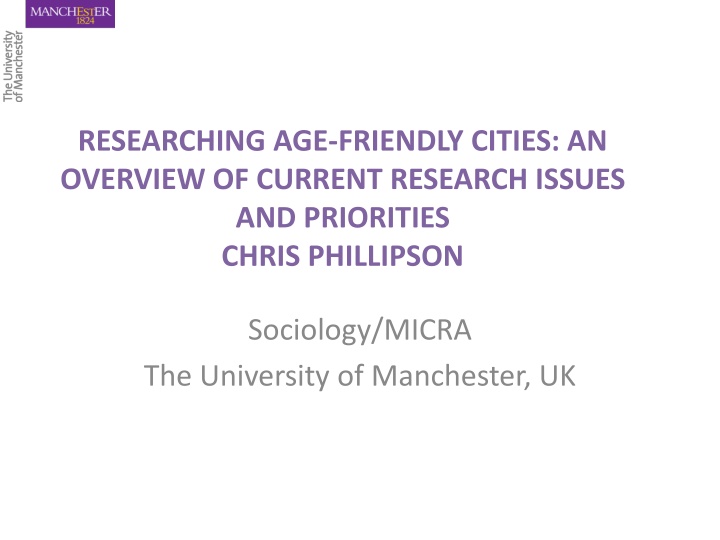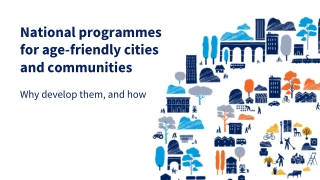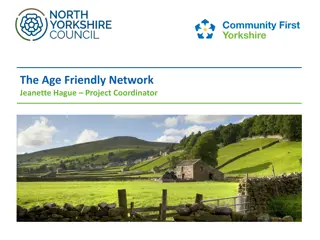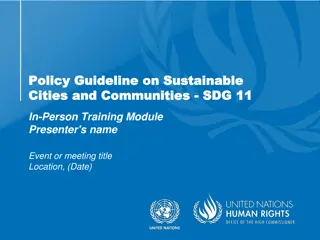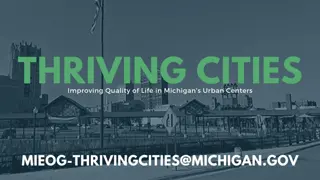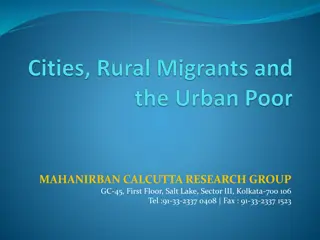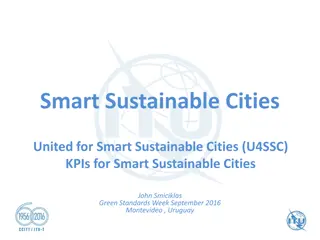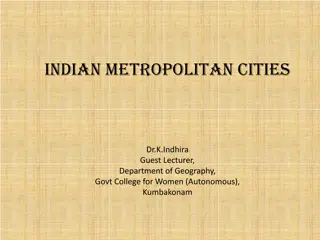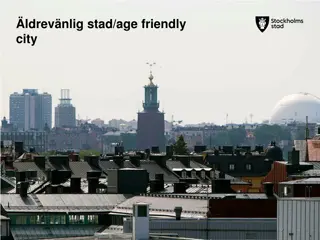Researching Age-Friendly Cities: Overview of Current Research Issues
This article provides an overview of age-friendly cities, discussing the importance, challenges, strategies, key research questions, and the components that make a city age-friendly according to the World Health Organization. It also highlights the background of the age-friendly cities concept, key developments, and global initiatives in this area.
Download Presentation

Please find below an Image/Link to download the presentation.
The content on the website is provided AS IS for your information and personal use only. It may not be sold, licensed, or shared on other websites without obtaining consent from the author.If you encounter any issues during the download, it is possible that the publisher has removed the file from their server.
You are allowed to download the files provided on this website for personal or commercial use, subject to the condition that they are used lawfully. All files are the property of their respective owners.
The content on the website is provided AS IS for your information and personal use only. It may not be sold, licensed, or shared on other websites without obtaining consent from the author.
E N D
Presentation Transcript
RESEARCHING AGE-FRIENDLY CITIES: AN OVERVIEW OF CURRENT RESEARCH ISSUES AND PRIORITIES CHRIS PHILLIPSON Sociology/MICRA The University of Manchester, UK
AREAS FOR DISCUSSION Background to the age-friendly approach Why the debate on age-friendly cities & communities? Challenges to developing age-friendly cities and communities Developing a strategy for developing age-friendly communities Key research & policy questions
Background to AFCs Concept developed by World Health Organization: An age-friendly city is an inclusive and accessible community environment that optimizes opportunities for health, participation and security for all people, in order that quality of life and dignity are ensured as people age . WHO (2015) Measuring the Age-Friendliness of Cities
WHAT MAKES FOR AN AGE-FRIENDLY CITY? WHO GUIDE (2007) Outdoor spaces and buildings (e.g. public toilets, well-maintained pavements) Transportation (reliable, frequent) Housing (affordable, support to age in place ) Social Participation (outreach for those isolated) Respect and social inclusion (anti- discrimination)
WHAT MAKES FOR AN AGE-FRIENDLY CITY? WHO GUIDE (2007) Civic participation and employment (good quality employment, volunteering) Communication and information (good access to information about services & activities) Community support and health services (good range of services, community emergency plans in place).
BACKGROUND TO AFCs 2006 Global Age-friendly cities project to identify factors which make urban environments age-friendly . 2010 Launch of Global Network of Age-Friendly Cities (320 cities & communities across 80 countries 2017 figures). 2011 1stInternational Conference on Age-Friendly Cities (Dublin) 2013 2ndInternational Conference on AFCs (Ottawa) 2016 International Federation on Ageing, Global Conference on Ageing, Brisbane.
INFLUENCES ON AGE-FRIENDLY MODEL Age-friendly approach emerged from public health context linked with promotion of active ageing (WHO, 2002) Supported also by research in environmental gerontology importance of home and neighbourhood for identity (Rowles & Chaudhury, 2005)
INFLUENCES ON AGE-FRIENDLY MODEL 80% of the time of people aged over 70 is spent at home and immediate surroundings, hence the importance of a high quality physical environment (Wahl et al., 2012). Emphasis on ageing in place in health & social care policy (Wiles et al., 2012) although some concern that the places in which ageing took place were not fit for purpose (Scharf et al., 2002; Golant, 2014)
WHY THE DEBATE ON AGE-FRIENDLY CITIES? DEMOGRAPHIC: POPULATION AGEING PUBLIC POLICY: DEBATES ABOUT PRESSURES FACING CITIES
Figure 1. Projected change in people aged 65 years and over in selected capital cities, 2014-2031, contrasted with total population Projected total population: 2031 Projected total number of persons aged 65 and over: 2031 Increase in number of people aged 65 and over 10,328,000 1,484,000 500,600 3,836,300 844,000 161,000 2,188,800 439,800 146,300 1,245,700 189,000 44,600 598,000 68,000 18,300 318,700 56,000 14,800 Sources: Institut de la du Quebec (2014); Insee, modele OMPHALE; Senatsverwaltung f r Stadtentwicklung und Umwelt Berlin (2016); ONS (2016). *Berlin 2014-2030, ** Montreal 2011-2031.
Why the Debate on Age-friendly Cities? Public Policy Issues Sustainable Cities How can urban development be managed to meet the needs of current and future generations? Harmonious Cities (UN-Habitat) How can we achieve social justice and fairness in the city? Lifetime homes and neighbourhoods. How can we best support ageing in place ? Impact of urban regeneration/gentrification Exclusionary affects on particular groups of older people 12
AFCs as a response to experience of urban life Fear of Crime/Feelings of insecurity (despite low levels of victimisation) may limit participation in normal daily life : 33% -50% of older people may feel unsafe moving around their neighbourhood at night (Office of National Statistics, 2016). Contrast between older people ageing in place and highly mobile (student/professional) populations. Access to Amenities and Services: Social participation increases with access to wide range of facilities Broader range of social networks Cultural and social diversity 13
Age-friendly cities & the political economy of urban change Rapid expansion of Global Network of AFCs but this has to be placed in a context of: Economic recession Contraction of welfare state Austerity policies Intensification of global competition between cities (Walsh et al., 2015; Sassen, 2014; Gamble, 2016)
Research questions How does urban development influence AFCs? To what extent has the development of AFCs been affected by recession/austerity policies? Does being an AFC protect older people from cuts to social programmes? How does the AFC model fare given competition with other priorities/vested interests? What is the basis for an alternative age-friendly agenda?
Examples New York Manchester London Canberra, Melbourne and Sydney Barcelona Madrid San Francisco (Buffel & Phillipson, 2016)
Problems facing global age-friendly cities The gentrification problem The ownership problem The austerity problem
Development of AFCs coincided with. Dismantling of regulatory frameworks to control urban development coincided with attempts to develop age-friendly cities (Sudjic, 2016) Polarisation in the distribution of wealth and power etched into the spatial forms of our cities (Harvey, 2012) Deterioration of public spaces in de- industrialising cities affected by institutional disengagement (Gans, 1972)
Developing AFC policies for unequal cities Focus on housing as the pivot for AFCs Focus on ageing in the community Focus on urban management Focus on embedding AFC work in a radical public policy agenda
Transportation Outdoor spaces and buildings Social Participation HOUSING Community support and health services Respect and social inclusion SECURITY & Choice Civic Communicati on and information participation and employment
Focus on housing Role of international developers and global economic elites distorting housing markets: ghost streets ; 10% of central London properties registered to offshore tax havens (Booth et al., 2016) as investment vehicles. Decline of affordable housing (Navarro & Lee, 2014; Dorling, 2015) Increase and greying of homeless population (Desmond, 2016; NYT, 2016) Lifetime renting for those on low and middle incomes staying in cities (Projections: 60% 20-39 renting; 21% 45-54 in UK by 2025, PwC, 2016)
Housing & neighbourhood networks Neighbourhoods can be viewed as environments in which social relations and identity are constructed Gardner (2011 Jrnl of Aging Studies) highlights the importance of what she terms natural neighbourhood networks which complement family ties: neighbours, local businesses, strangers Neighbourhoods have third spaces which may be especially important to older people: seats by bus stops; cafes; entrances to buildings (i.e. zones of transition)
Table 1: Friendships in the neighbourhood: by selected age groups and sex, 2009-2010 (UKHLS): Strongly agree etc. that friendships in neighbourhood are important to me. UK All % Men % Women % 50-54 64 61 67 55-59 66 63 69 60-64 71 68 74 65-69 75 71 79 70-74 81 78 84 75-79 81 79 83 80 and over 82 81 83 All aged 16 and over 60 57 64
Table 2: Belonging to the neighbourhood: selected age groups and sex, 2009-10 (%) UKHLS (Strongly agree I feel I belong to this neighbourhood) UK All Men Women 50-54 69 68 70 55-59 73 73 74 60-64 76 75 76 65-69 80 79 81 70-74 84 83 86 75-79 85 84 85 80 and over 84 84 84 All aged 16 and over 66 64 68
Table 3: Attitudes towards the neighbourhood: proportion of older people agreeing or disagreeing with statements relating to neighbourhood (N=600) (%) Statement Agree Neither agree nor disagree Disagree I believe my neighbours would help me in an emergency 10 12 78 I frequently stop and talk with people in my neighbourhood 71 11 18 I like to think of myself as similar to the people who live in this neighbourhood 69 12 19 I feel I can trust the people in my neighbourhood 58 21 21 This neighbourhood is a good place to grow old in 52 17 31 During the last two years my neighbourhood has got better as a place to live in 30 27 43 Source: Keele Urban Deprivation Study
Ageing in community: strategies for co- operation and solidarity Co-location of services (Stafford, 2012; Scharlach and Lehning, 2016) Village model & Naturally Occurring Retirement Communities Co-housing (Pedersen, 2015; http://sydneycohousing.blogspot.co.uk/) Co-operative urban design (White et al. 2013) Co-production strategies with older people (Buffel, 2014)
URBAN DEVELOPMENT AND PROMOTING AGE- FRIENDLY CITIES AFC model needs to recognise importance of building coalitions with urban interest groups. Weakness of current model is that operates outside the political & economic interests which shape urban environments. AFC strengthened if embedded in networks of power which control urban life (e.g. Caro, 2015)
DEVELOPING A RADICAL PUBLIC POLICY AGENDA Embedding age-friendly policies in urban economic development as well as public health Building coalitions with urban interest groups Developing new sources of finance to develop age- friendly cities: Creation of an inclusive city fund : levy on property sales on homes above a certain value: fund to be used to develop social/affordable housing (Atkinson et al., 2016). Land value tax on undeveloped developable land worth above a certain value: as an encouragement for new building and housing investment (Dorling, 2015).
What are the key research challenges for AFCs to address? What does age-friendliness actually mean: what does it look like? How can it be assessed or measured? (WHO, 2015) What are the benefits? How does it vary at neighbourhood, city, and regional level? Does it work for some groups but not others? How does it link to other policy interventions relating to health and social care? How is it affected by broad processes of urban change & development?
What are the Key Policy Questions for AFCs to Address? Cities are viewed as key drivers for economic success the urban renaissance but can they integrate ageing populations as well? Can the resources of the city be used to improve quality of life in old age only 1 in 20 older households may have the money to take advantage of what great cities have to offer. Can cities be designed in the interests of all age groups? 31
What are the Key Policy Questions for AFCs to Address? Opportunity to use age-friendly model to stimulate linkages between housing, health, and community-based services. Importance of developing co-ordinated approach whose responsibility? Financial incentives? Legislation? Developing more ambitious targets for age-friendly cities, environments and communities.
Age-friendly movement needs to tackle the big issues Instead of or perhaps in addition to the multidimensional frameworks that currently organize age-friendly work, it is time to narrow the focus of the work and concentrate not on all things needed to become age-friendly but the strategic opportunities currently available. It is time to pull big levers (e.g. in housing finance, transportation finance, economic development) that if successful could greatly facilitate age-friendly work . Lawler, K (2015) Age-friendly communities: go big or go home. Public Policy & Aging Report, 25.
SELECTED REFERENCES Buffel, Phillipson, C. and Scharf, T. 2013. Experiences of neighbourhood exclusion and inclusion among older people living in deprived inner-city areas in Belgium and England. Ageing & Society, 33, 89-109. Buffel, T. (2015) Researching Age-Friendly Communities: Stories from Older People as Co-Researchers. Manchester: The University of Manchester Library. Caro, F. and Fitzgerald, K. (2016) International Perspective s on age-friendly cities. London: Routledge Minton, A. (2009) Ground Control. Penguin Books New York: Office of the Comptroller (2014) The Growing Gap: New York City s Housing Affordability Challenge.
REFERENCES Phillipson, C. (2013) Ageing. Polity Press Phillipson, C (2011) Developing age-friendly communities: New approaches to growing old in urban communities. In Settersten, R and Angel, J (eds) Handbook of Sociology of Aging. New York: Springer Walsh, K. (2015) Interrogating the age-friendly community in austerity: myths, realities and the influence of place context . In Walsh, K., Carney, G. and L ime, (eds) Ageing Through Austerity. Bristol: Policy Press. Zukin, S. 2010. The Naked City: The Death and Life of Authentic Urban Places. New York: Oxford University Press
